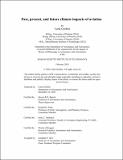| dc.description.abstract | Commercial aviation is one of the hardest-to-decarbonize contributors to climate change and accounts for approximately 5% of anthropogenic radiative forcing due to its CO₂ and non-CO₂ emissions. As the industry grows faster than its efficiency improvements, aligning its growth with international climate goals becomes increasingly urgent and challenging. To enable data-driven decision-making, this thesis investigates aviation’s historical emissions, present-day climate impacts, current damages due to marginal emission changes, and potential pathways to reach netzero climate impacts by 2050.
First, the research develops a consistent bottom-up emissions inventory for commercial civil passenger aviation from 1980-2019, quantifying how emissions patterns such as spatial, temporal, and compositional characteristics have varied over time. Results show that, while fuel consumption increased by 330%, capacity, measured as available seat miles, grew by 560%. This growth has been regionally heterogeneous, with the emissions share over Asia growing from 7% to 23%, while emissions share over North America decreased from 55% to 25%. Over this time, the share of nighttime fuel consumption increased from 30% to 38%, due to an increase in aircraft utilization. Additionally, there has been a shift in the emissions composition, with the nitrogen oxides (NOx) emissions index increasing by 20%, while the non-volatile particulate emissions index decreased by 70%.
Second, this thesis quantifies aviation’s present-day climate effects using the bottom-up emissions inventory described above. Since contrails are responsible for an estimated 57% of aviation’s effective radiative forcing, we place a particular focus on modeling contrails. Using a mediumfidelity aircraft plume model and ERA5 reanalysis weather data, our results indicate that contrail 3 impacts increased by 460% from 1980 to 2019, outpacing growth in annual fuel consumption. Per flight distance, contrail impacts varied less than 10% over this time. However, underlying drivers did not remain constant. The fraction of flight segments that cause contrails increased by 32%, while the radiative forcing per distance of contrail decreased by 24%. We additionally quantify for the first time how different assumptions regarding the treatment of contrails mixing with ambient air could change their lifetime by a factor of three.
Third, this thesis calculates the impacts of marginal changes in aviation emissions on climate and air quality, supporting cost-benefit analyses of emissions interventions. Climate and air quality impacts are monetized on a per unit emissions basis, using a simplified climate model and sensitivities from the GEOS-Chem global chemistry-transport model. We find that cruise emissions account for 90% of impacts per fuel unit, with 49-81% arising from air quality effects depending on the discount rate. Collectively NOx, CO2, and contrails cause 97% of the total impact. By estimating the first-order contribution to variance we find that the equilibrium climate sensitivity, climate damage function, and value of statistical life contribute to the greatest uncertainty in outputs.
Finally, we evaluate pathways through which alternative energy carriers and avoidance of nonCO₂ impacts could lead aviation towards net-zero climate impacts by the year 2050. We consider the alternative energy carriers: synthetic fuels from biomass; synthetic fuels from green hydrogen and atmospheric CO₂; and the direct use of green liquid hydrogen. We also perform a meta-analysis to evaluate how these alternative fuels could affect the non-CO₂ impacts and how contrails can be avoided through small scale adjustments in flight altitude. We find that 50% of fleet-wide contrail length can be avoided for a 0.88% fleet-wide fuel burn penalty (5th to 95th percentile range 0 to 2.51). Thereafter avoiding subsequent contrails becomes more fuel costly, with an additional 20% avoidance requiring double the additional fuel. Together with continued efficiency gains, and assuming 50% avoidance of contrails, such an energy transition could reduce annual lifecycle aviation CO₂ emissions by 89-94% compared to year-2019 levels, despite a 2-3-fold growth in demand by 2050. If these costs were passed directly on to passengers, ticket prices would rise by no more than 15% compared to a no-intervention baseline. However, the pathways we identify reduce aviation CO₂-equivalent emissions by 46-69% only; more action is required to mitigate non-CO₂ impacts.
Collectively, this thesis provides perspective into aviation’s past, present, and future climate impacts. These results indicate substantial growth and impacts over the past 40 years, and highlight CO₂ and contrails as the largest contributors. Though, through sustained investment in alternative fuels, and contrail avoidance measures, our results also indicate, future mitigation is possible. However, to meet the global climate goal of net zero emissions by 2050, the transition needs to start now. | |
